The night the bombs fell on Bishopbriggs


A balloon barrage was set up at what is now Bishopbriggs Golf Range and a camp established at what is now Low Moss prison. An army camp with ack-ack guns and searchlights was set up in a field on Rushiehill farm and air raid warning sirens were installed at Bishopbriggs police station.
Although clearly worried, most local folk would say, “Let’s hope it comes to nothing”.
Advertisement
Hide AdAdvertisement
Hide AdSuch hopes were dashed, however, when war was declared on Sunday, September 3, 1939. Although Bishopbriggs was considered a ‘safe place’, some school children were evacuated, mostly to rural areas. Other children were evacuated to Auchinairn and Bishopbriggs from built up areas. The siren would sound occasionally. Some people took to their air raid shelter, but others chose to remain in the comfort of their own home.
On March 13, 1941, Clydebank was bombed. By the second night, only seven Clydebank homes remained undamaged.
Refugees arrived at Bishopbriggs, some with only the clothes they stood up in. Quite a number were temporarily accommodated in the middle building of Bishopbriggs Higher Grade School while suitable accommodation was found for them.
Then, at approximately 11.30pm on April 7, 1941, Bishopbriggs was bombed. Things became personal at this point.
Advertisement
Hide AdAdvertisement
Hide AdA Bishopbriggs couple were at a dance in Kirkintilloch when the alert was sounded. The wife sheltered there while her husband walked home to be with their teenage sons.
Harry Fox was on fire watch duties at a Bishopbriggs school. At about 11pm he asked permission to ‘run up the road to check on his wife’. She was sheltering with neighbours.
When Harry returned, the middle building of the school had received a direct hit, the fire watch post was demolished and his colleague killed outright.
A bomb also demolished one of the buildings opposite the school, in South Crosshill Road.
Advertisement
Hide AdAdvertisement
Hide AdMeanwhile, a family consisting of a father, mother and four girls had elected to remain in their house, beside the bank in Kenmure Avenue. They heard an object, issuing a high pitched sound and heading through the air towards their home. The mother took two of the girls by the hand, the father took hold of the other two and said, “When I say run everybody run.” Just where they were going to run to was far from clear.
Fortunately, the flying object missed their house and landed in Bishopbriggs park creating a loud explosion and leaving a deep bomb crater.
Others who remained in their houses that night included a girl called Nessie. The ceiling of her bedroom collapsed and injured her knee. A boy called Alex was also in his house and remembers a light bulb striking the ceiling twice and not breaking. He was fortunate, virtually every window in the centre of Bishopbriggs was broken.
Several houses received structural damage. In one case the damage was not discovered until the family carried out extensive redecorating many years later.
Advertisement
Hide AdAdvertisement
Hide AdIn addition to adults fire watching a number of teenage boys were also on duty that night, acting as messengers. Just as well, the telephone exchange, then one up in a tenement on Kirkintilloch Road, was also damaged.
Not that many residents had telephones in those days but doctors etc., had to be summoned by the boy messengers.
It wasn’t until the following morning that the full extent of the damage was known.
Seven people were killed, or died later as a result of injuries sustained resulting from enemy action. Their names appear on the Bishopbriggs war memorial.
Advertisement
Hide AdAdvertisement
Hide AdWhy was Bishopbriggs bombed? Several explanations have been offered. One was that the enemy aircraft was jettisoning their bombs while on their way home.
Another explanation offered is that a steam engine fire box had been opened just outside Bishopbriggs station prior to the first bomb falling, so the railway line could have been the target.
However, there may have been a more sinister reason. Part of Blackies print works (where the Oregano now stands) had been assigned to the manufacturing of ammunition and this just might have been the target.
But how would the Germans know about this? Was there a spy living in Bishopbriggs? Nonsense! Then again, on one occasion a German propaganda broadcast mentioned the fact that a shop in Bishopbriggs had just been painted.